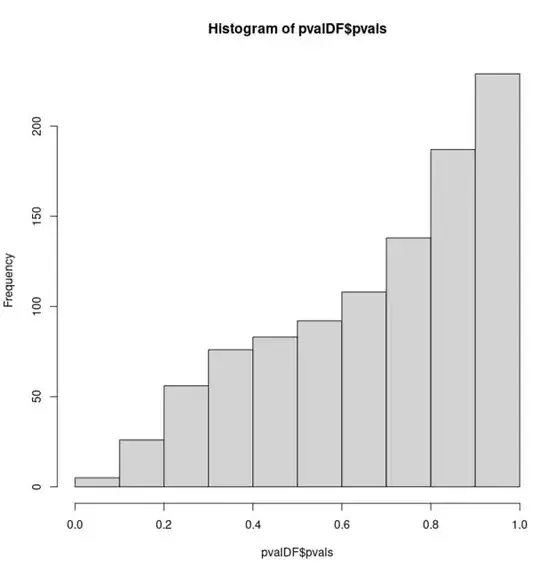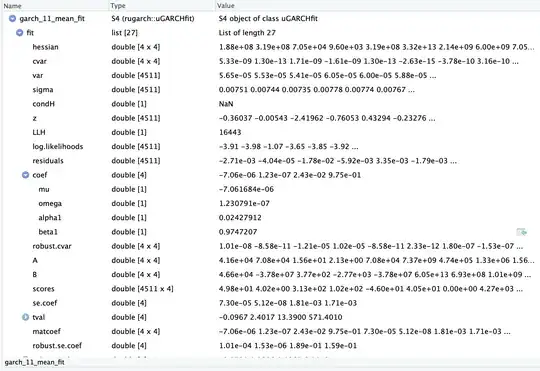I am interested in generating Gaussian mixture distributions as the null distributions for a series of two-sample test simulations. It is a well established fact that p-values follow a uniform distribution when the null hypothesis is true, and several excellent explanations have been offered on Stack Exchange. I observe this when testing between two Gaussian distributions, but as soon as I begin to test between two multi-modal Gaussian mixture distributions the distribution of p-values departs from uniformity and exhibits negative skewness. Why am I observing this behavior?
Examples
Below I demonstrate the expected uniform distribution of p-values from a two-sample Anderson-Darling test using the kSamples R package. (Please forgive the inefficiently written parts of the code.)
library(kSamples)
numsims <- 1000
repNums <- 1:numsims
pvalDF <- data.frame(ii = rep(0, length(repNums)),
pvals = rep(0, length(repNums)),
seed = rep(0, length(repNums)))
for (ii in 1:numsims) {
set.seed(123 + ii)
sample1 <- rnorm(50, mean = 0.5, sd = 0.05)
sample2 <- rnorm(50, mean = 0.5, sd = 0.05)
n1 = length(sample1)
n2 = length(sample2)
samples <- scale(c(sample1, sample2))
sample1 <- samples[1:n1]
sample2 <- samples[n1+1:n2]
ad_out <- ad.test(sample1, sample2)
pvalDF$ii[ii] <- ii
pvalDF$pvals[ii] <- ad_out$ad["version 1:", 3]
pvalDF$seed[ii] <- 321 + ii
}
hist(pvalDF$pvals, xlim = c(0, 1))
However, as soon as the null distribution is constructed as a mixture of two Gaussian distributions the distribution of p-values departs from uniformity:
numsims <- 1000
repNums <- 1:numsims
pvalDF <- data.frame(ii = rep(0, length(repNums)),
pvals = rep(0, length(repNums)),
seed = rep(0, length(repNums)))
for (ii in 1:numsims) {
set.seed(123 + ii)
sample1.1 <- rnorm(25, mean = 0.5, sd = 0.05) # Here are the new two samples each
sample1.2 <- rnorm(25, mean = 0.75, sd = 0.05) # generated as a mixture from two
sample1 <- c(sample1.1, sample1.2) # identical Gaussian distributions.
sample2.1 <- rnorm(25, mean = 0.5, sd = 0.05) #
sample2.2 <- rnorm(25, mean = 0.75, sd = 0.05) #
sample2 <- c(sample2.1, sample2.2) #
n1 = length(sample1)
n2 = length(sample2)
samples <- scale(c(sample1, sample2))
sample1 <- samples[1:n1]
sample2 <- samples[n1+1:n2]
ad_out <- ad.test(sample1, sample2)
pvalDF$ii[ii] <- ii
pvalDF$pvals[ii] <- ad_out$ad["version 1:", 3]
pvalDF$seed[ii] <- 321 + ii
}
hist(pvalDF$pvals, xlim = c(0, 1))
This seems counter-intuitive to me. Both null hypotheses (the underlying distributions for the two samples are equal) are true, yet, the p-values are no longer uniformly distributed for the latter bimodal samples.
While somewhat redundant, this effect is exaggerated further by adding additional Gaussian distributions to both samples:
numsims <- 1000
repNums <- 1:numsims
pvalDF <- data.frame(ii = rep(0, length(repNums)),
pvals = rep(0, length(repNums)),
seed = rep(0, length(repNums)))
for (ii in 1:numsims) {
set.seed(123 + ii)
sample1.1 <- rnorm(10, mean = 0.5, sd = 0.05)
sample1.2 <- rnorm(10, mean = 0.75, sd = 0.05)
sample1.3 <- rnorm(10, mean = 1, sd = 0.05)
sample1.4 <- rnorm(10, mean = 1.25, sd = 0.05)
sample1.5 <- rnorm(10, mean = 1.5, sd = 0.05)
sample1 <- c(sample1.1, sample1.2, sample1.3, sample1.4, sample1.5)
sample2.1 <- rnorm(10, mean = 0.5, sd = 0.05)
sample2.2 <- rnorm(10, mean = 0.75, sd = 0.05)
sample2.3 <- rnorm(10, mean = 1, sd = 0.05)
sample2.4 <- rnorm(10, mean = 1.25, sd = 0.05)
sample2.5 <- rnorm(10, mean = 1.5, sd = 0.05)
sample2 <- c(sample2.1, sample2.2, sample2.3, sample2.4, sample2.5)
n1 = length(sample1)
n2 = length(sample2)
samples <- scale(c(sample1, sample2))
sample1 <- samples[1:n1]
sample2 <- samples[n1+1:n2]
ad_out <- ad.test(sample1, sample2)
pvalDF$ii[ii] <- ii
pvalDF$pvals[ii] <- ad_out$ad["version 1:", 3]
pvalDF$seed[ii] <- 321 + ii
}
hist(pvalDF$pvals, xlim = c(0, 1))
What is causing this effect? I don't believe this is related to this post as these p-values can take on a much larger number of possible values. I have also reproduced this effect using a different test designed for bivariate samples.



